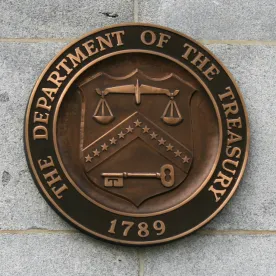The U.S. Department of the Treasury recently issued its long-awaited guidance on two cash monetization options available for renewable energy projects under the Inflation Reduction Act of 2022 (IRA or Act) – Transferability and Direct Pay. These provisions provide developers of renewable and alternative energy projects the opportunity to obtain cash payments for the value of the federal energy tax credits for which their projects qualify.
Under the Transferability provisions, project owners can sell or transfer their tax credits for cash to unrelated parties. Under the Direct Pay provisions, tax-exempt entities that cannot use tax credits can be treated as if they had paid taxes in the amount of the credits, for which they can then receive a cash refund. Clean hydrogen, carbon sequestration (CCS) and advanced manufacturing projects can also take advantage of Direct Pay. The new provisions expand the ability of renewable energy project developers, including tax-exempt entities, to build new renewable energy projects more quickly and affordably.
The Transferability and Direct Pay provisions enacted under the IRA left open many questions as to how the provisions would be applied. Among them were:
-
How would the provisions work in a partnership?
-
If a tax credit was sold to a third party, who ran the risk of recapture – the transferor or the transferee?
-
Can a tax-exempt entity using Direct Pay sell/transfer its right to the tax refund to a nonqualifying entity under the transferability provisions?
-
Could a project sell some, but not all, of its tax credits?
-
Can a tax-exempt organization take advantage of Direct Pay if it enters into a partnership with a for-profit entity?
-
Can a tax credit owner sell its credits ahead of time to raise cash for its projects?
The new Treasury guidance answers these questions and more.
Transferability
Under the Transferability provisions, renewable projects that qualify for nine different types of tax credits may sell some or all of those credits for cash. Neither receipt of the cash payment nor the purchase of credits is taxable to either party. Importantly, if the purchaser pays less than the full value for the tax credits, it is not taxed on the incremental value it obtains through the transaction. A transfer cannot be made by an entity that is eligible for Direct Pay.
The sale or transfer of the credits must 1) be for cash, 2) be made to an unrelated person, and 3) be sold or transferred only once. The credit period for transferred credits is 23 years (including three years for carrybacks). The transferee must use the credit in the earliest possible year following the transfer.
Can a Credit Holder Sell Its Credits in Multiple Parts? Yes. The transferor can break its tax credits into multiple components and sell different amounts of the credits to different purchasers. There is no limit on the number of transferees, as long as the transfer as a whole does not exceed the amount of the tax credits owned by the transferor.
Can a Credit Holder Sell Carryforwards and Carrybacks? No. Carryforwards or carrybacks are not transferable. However, the purchaser of credits may carry them back three years prior to the year in which it purchased the credits.
Who Runs the Risk of Recapture? Once a transfer occurs, the transferee is then treated as the taxpayer and runs the risk of recapture. If, for example, following the transfer of the credits, the eligible property owned by the transferor is sold during the recapture period, the tax credits are subject to recapture and the transferee (credit recipient) bears the financial consequences. If a recapture event occurs, the transferor must notify the transferee of the recapture event, and the transferee must notify the transferor of the recapture amount. An exception to this is when there is a reduction in interest by a partner in a partnership. In that instance, the partner suffers the recapture rather than the transferee.
The Treasury regulations draw a distinction between an excessive credit transfer and a recapture situation. An excessive credit transfer is one where the original amount of credits transferred from the seller to the buyer are excessive, whereas a recapture event is one where the original transfer amount was correct, but a subsequent event occurred triggering recapture. If excessive credits are sold by the transferor to the transferee, the transferee bears the risk. The transferee will be responsible for refunding the value of the excessive tax credits taken, plus a 20% penalty on the excess amount. The penalty will not apply if the transferee can demonstrate reasonable cause to the satisfaction of the IRS.
Because Internal Revenue Code (Code) places the risk in a transfer scenario on the transferee, the transferee will require an indemnification from the transferor in the event the tax credits are recaptured or disallowed. The parties to a partnership also will need to carefully negotiate a risk allocation provision in their partnership agreement so that a partner whose actions led to the loss must cover the financial risk to the partnership. Nothing in the regulations prevents such an arrangement.
Tax Treatment of Proceeds. Transferees must pay cash for the eligible credits. The payment may not be treated as a tax deduction to the transferee. The cash payment received for the credits also is not treated as income to the transferor. Conversely, if the transferee pays less for the credit than its tax value (which is expected), for example, 90% of the cash value, gross income is not attributed to the transferee.
Despite transferring the tax credits, the transferor nevertheless must apply the basis reduction and recapture rules as if the transferor received the credit. With respect to the investment tax credit (which requires a basis reduction equal to 50% of the credit), the transferor must reduce its basis based on the amount of the credit claimed, not the amount of consideration received in the transfer transaction. For example, if a project owner sells a $100,000 credit for $90,000, it must reduce its basis in the energy property by half of $100,000, i.e., $50,000, not half of $90,000.
The Transferability rules do not provide for the transfer of the depreciation benefits associated with a project. Only those that have an ownership interest in a project may claim the tax depreciation benefits. On a present value basis, the depreciation benefits of a renewable energy project are generally considered to be worth 14 cents on each dollar invested. Most renewable energy projects are depreciated on a front-loaded basis. Accordingly, large-scale clean energy projects may still be reliant on traditional tax-equity financing in order to monetize both the credits and the depreciation benefits.
A purchaser of tax credits is not subject to the at-risk rules under Code Section 465. A seller’s ability to transfer the credit, however, may be limited under the at-risk rules. The value of the tax credits that can be sold must be determined based on any limitations on the use of the credits by the owners of the eligible property. For example, if the tax credits are limited by the at-risk rules in a particular year (e.g., an owner of the qualifying property has non-qualified, non-recourse debt), that limitation would apply to the value of the credits that can be transferred to the transferee.
How are Transfers by Partnerships and S Corporations Treated? Where the property qualifying for the tax credits is held by a pass-through entity such as a partnership or S corporation, the election to transfer the credit must be made at the entity level. A partner or shareholder may not elect to transfer its proportionate share of the credits. The cash payment received must also be distributed to the members or shareholders based on what the partners’ distributive shares of the transferred credit would have been.If the recipient of the cash payment is a partnership, the payment must be allocated to the partners in the same proportionate amount as the specified credit portion would have been allocated to the partners if it had not been transferred, which in most instances will be in accordance with the partnership agreement.
Transferring Credits. To transfer a credit, the taxpayer/transferor must elect to transfer the credit on its tax return for the taxable year for which the credit is determined by the due date of such return, including extensions of time. Once a taxpayer makes a transfer election, the election cannot be later revoked as to any portion of the credit.
Once the election has been made, the transferee must take the transferred credit into account in the first tax year following the election. Depending on when the transferee files, the first tax year could be the year following the year in which the transferor files for the election. However, the buyer of the credit may take the credit into account in making its estimated tax payments.
The transferor must file a transfer election statement with the IRS. The statement must describe the specific portion of the credit that is to be transferred and contain sufficient information to allow the transferee to identify the specified credit portion of the eligible credit property. The transferor and transferee must both acknowledge the notification of recapture requirements. The transferor also must represent that it provided the minimum documentation to the transferee to identify and validate the eligible credit property, any bonus credits amounts, and evidence of credit qualification. The transfer election statement must be filed by the earlier of the filing date of the transferor’s return for the taxable year for which the credit is determined, or the filing date on which the transferee’s return is due for the year in which the specified credit portion is considered.
In the case of a production tax credit (PTC) under Code Section 45, a transfer election must be made during each taxable year of the 10- or 12-year credit period. However, a transferor can enter into a long-term contract for the purchase of PTCs over the term in which the credits are available. Nonetheless, cash payments cannot be made by the transferee except during the year in which the transfer is made.
A transfer needs to be made based on a single eligible credit property. An entity owning two separate eligible properties will need to make separate transfer elections for the relevant portion of each property.
No Second Transfers. Tax credits may only be transferred once, and each transfer is irrevocable. An arrangement in which an intermediary broker/dealer receives the tax credits and then transfers them to a buyer is impermissible as it violates the no second transfer rule. A notable exception to that rule is where a credit is transferred to a pass-through entity. The allocation of credits by a pass-through entity to its direct or indirect owners is a permissible second transfer. However, certain rules apply to how a transferred credit may be allocated to partners and shareholders.
Can the Base Credit be Transferred Separately from the Bonus Portion of the Credit? No. The proposed regulations provide that “a specified credit portion of an eligible credit must reflect a proportionate share of each bonus credit amount that is taken into account in calculating the entire amount of eligible credit determined with respect to a single eligible credit property.” Accordingly, a purchaser could not, for example, buy a 30% investment tax credit (ITC) but not buy the 10% bonus credit attributable to domestic content. Although tax credits can be broken into multiple parts, the transfer of a bonus credit must be made in conjunction with the transfer of the base credit and reflect a proportionate share of the eligible credit (or portion of the eligible credit) being transferred.
Abuse of the Rules. The proposed regulations include a series of anti-abuse provisions. These provisions contemplate circumstances where transactions are made with the sole purpose of avoiding tax liability beyond the intent of the IRA. The guidance provided two examples to demonstrate when the anti-abuse rules would apply. For example, the rules would apply if a taxpayer overcharges or undercharges for services to a customer and overcharges for the sale of the tax credits to the same customer, in an attempt to avoid the customer recognizing gross income related to the provision of services.
Direct Pay
Under the new Direct Pay provisions, also referred to as the “elective payment” option, certain tax-exempt entities that previously could not take advantage of federal energy tax credits can receive a cash refund from the government for 12 types of energy tax credits as if they had overpaid taxes in the amount of the credit.
“Applicable entities” include tax-exempt organizations, states, and political subdivisions such as local governments, Indian tribal governments, Alaska Native Corporations, the Tennessee Valley Authority, rural electric cooperatives, U.S. territories and their political subdivisions, and agencies and instrumentalities of state, local, tribal, and U.S. territorial governments such as public schools, public universities, and hospitals. Clean hydrogen, CCS, and advanced manufacturing projects also qualify for Direct Pay, although there are additional rules applicable if the projects are owned by taxpaying entities.
Partnerships. One of the most discussed issues among tax practitioners was whether partnerships with Direct Pay eligible taxpayers may participate in Direct Pay. Treasury responded with a clear “no” – partnerships are not eligible for Direct Pay, even if all the partners are Direct Pay eligible. Given the importance of this issue, we expect Treasury to receive substantial comments on this point. There is a limited exception, where a direct pay eligible taxpayer enters into a partnership, but elects out of partnership treatment, in favor of an undivided co-ownership or tenancy in common structure.
For-Profit Entities Qualifying for Direct Pay. Direct Pay is also available for clean hydrogen production projects (Code Section 45V), CCS projects (Section 45Q), and advanced manufacturing projects (Section 45X), even if those projects are owned by taxable entities or a partnership. For those entities, an election must be made in the year in which the facility is placed in service. The election then applies to that year and each of the four subsequent taxable years ending before January 1, 2033. The electing taxpayer may subsequently revoke the application of the election but, if it does, the revocation applies to the specified year and each of the next five tax years, for which the revocation may not be revoked.
Determining the Amount of the Credit. Inherent in the Direct Pay rules is that the general limitations applicable to tax-exempt entities claiming the applicable tax credits are eliminated; for example, the tax-exempt use property rules. Generally, the eligible basis for the ITC (among other credits) is reduced if the taxpayer receives grants or tax-exempt financing. These rules do not apply to Direct Pay; rather a new rule applies which provides that the amount of a credit may not exceed the taxpayer’s out-of-pocket cost for the property. For example, a tax-exempt organization that receives a $750,000 grant and uses $250,000 of its own capital to build a solar PV facility, would be limited to a $250,000 credit, rather than the typical $300,000 (or more) credit.
Process For Electing Direct Pay. The Direct Pay option is subject to an annual election by the tax credit owner. For tax-exempt entities, once an election is made, it is irrevocable and applies for any taxable year for which the election is made. In the case of a taxable entity electing a Section 45 credit with respect to clean hydrogen, CCS, and advanced manufacturing, the election must be made for five consecutive taxable years, including the first taxable year in which the property is placed in service. In such cases, the electing taxpayer is allowed one revocation during the applicable period.
In general, an eligible entity must make an election by the due date by which it is required to file a tax return, including extensions or, if no return is required (such as for state and local governments or tribal entities), the date on which it would be required to file a return to report unrelated business income or a proxy tax under Section 6033(e). The date for eligible taxpayers claiming credits for clean hydrogen, CCS, or advanced manufacturing credits generally is the date by which they would normally file their tax returns for that year, taking into account any extensions.
For entities electing Direct Pay that do not meet the domestic content requirements, a penalty applies for projects beginning construction in 2024 (10% reduction in the credit amount) and 2025 (15% reduction in credit amount). Thereafter, the penalty disappears even if the domestic content requirement is not satisfied.
The Treasury Department and the IRS are issuing temporary regulations under §1.6418-4T that implement the pre-filing registration process described in §1.6418-4 of the proposed regulations. The temporary regulations require eligible taxpayers that want to elect to transfer eligible credits under Section 6418 to register with the IRS through an IRS electronic portal in advance of the eligible taxpayer filing the return on which the election under Section 6418 is made.
Opportunity to Comment. The Treasury guidance has been published in the form of proposed regulations, which will have a formal 60-day public comment period. Those wishing to file comments on the proposed rules may do so through August 14, 2023.




 />i
/>i

